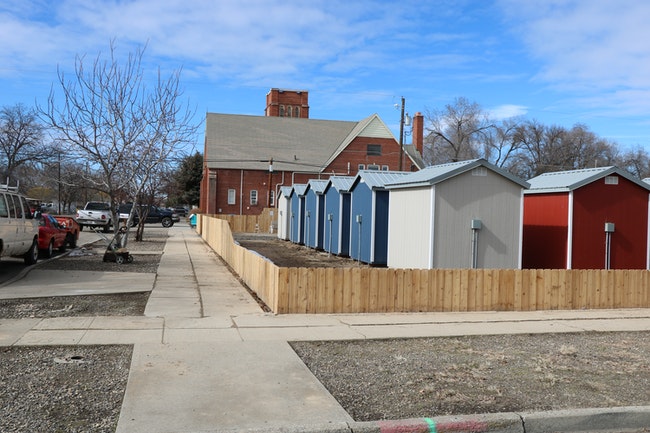
The tiny homes shelter project in Ontario. (The Enterprise/Liliana Frankel)
ONTARIO – Against the advice of city staff, the Ontario City Council voted down a proposal to extend temporary homeless shelter’s operations through the end of June and give it a chance to become permanent.
City Manager Adam Brown had recommended that the tiny homes, as they are known, be allowed to remain open through June 30, and that city council then “proceed with the land action needed to make (the shelter) a permanent site for year round transitional housing.”
The shelter effort was scheduled to close April 30.
The call to make the shelter permanent was never taken up by the council as it discussed the matter on Tuesday, April 20.
Councilors John Kirby, Eddie Melendrez and Michael Braden voted to extend the shelter’s operations till June 30. But Councilors Freddy Rodriguez, Sam Baker, and Ken Hart and Mayor Riley Hill voted against it, killing the recommendation.
After an outburst from shelter advocates watching in the audience who cried, “Shame on you!” before making a dramatic exit, Hill proposed to instead let the shelter operation continue through the end of May. That proposal passed unanimously.
Barb Higinbotham, executive director of Community in Action, which has partnered with the city and several other groups to run the site, said she felt “raw” after realizing the lack of city support for the shelter.
“We’re the ones that are going to have to evict those 16 households,” she said, referring to the residents of the tiny homes. “We are going to work really hard to transition the folks at the shelter into step-up housing and transitional housing, and some of them will likely be turned back to the streets, to homelessness.”
Last year, the tiny homes pilot project was an unqualified success. In 30 days, Community in Action placed 38 homeless families in more stable living arrangements.
This year, 10 out of 31 shelter residents have moved on to something bigger and better. The lower number can be explained by the pandemic and its impact on Ontario’s “sparse” supply of housing, said Priscilla Garcia, housing programs manager at Community in Action.
“We’re doing the best that we can between our partnership with Origins (Faith Community) and our case managers at Community in Action,” she said.
Hart, who voted against the motion, said that his opposition was not a reflection of his feelings about the shelter program, which he described as “doing an amazing job.”
He said the city needed to live up its promise – “the commitment that we made to the neighborhood when we put (the homeless shelter there) was that it would be temporary.”
Kirby, who proposed the original motion to extend the shelter’s lifespan until June 30, said that he hadn’t done so with the intent of making a permanent shelter possible on the current site.
“We need to try and help solve the problem without impacting private citizens. With my motion, I just wanted to give them as much time to get their act together before they had to move,” he said.
The current shelter site at Northwest First Street and Northwest Third Avenue is the second in two years. According to Brown’s staff report, costs to move the shelter again would run between $20,000 and $30,000.
The shelter’s impact on private citizens was front and center at the council meeting, which residents of both the shelter and its surrounding neighborhood attended. Only the neighborhood residents, however, had their views invited by the council.
“This soup kitchen and little houses are by far the worst thing that’s happened to my neighborhood since 1973,” said Alan Vincent, citing perceived increases of garbage, dumpster divers, theft and trespassers.
Vincent also said he worried that his property would be devalued by the presence of the shelter.
This concern was shared by María Jarquin, another neighbor who complained of the impact the homeless shelter had on her childcare business.
Jarquin said that before the homeless shelter’s arrival, she had always had between 8 and 10 children in her care. Now, she has none, which she attributed to fears that the children will hear bad words or fighting from the shelter while at her house. She said the loss of income has forced her into a new profession.
“I got a permit to take care of people with disabilities because I have to work somehow,” Jarquin said.
These concerns weren’t the first the council had heard about the homeless shelter.
In February, Ingeborg Dickerson, a landlady who owns several buildings near the site, alleged that a shelter resident had “pulled a knife” on one of her tenants. She also complained of noise at night and insinuated that drug deals were taking place on or near shelter premises.
Now that the tiny homes project will be closing, at least for the summer, Higinbotham said she wasn’t sure what lay ahead for housing initiatives in Ontario.
“You can continue to kick the can down the road, but at some point in time, the city of Ontario’s going have to do something about its homeless population,” she said. “The City Council alluded to developing a more comprehensive plan during the City Council meeting, and I would support that any way I can.”
News tip? Contact reporter Liliana Frankel at [email protected] or 267-981-5577.
SAFEGUARD YOUR LOCAL NEWS
Take one action today to help the Enterprise grow and do more for the community through accurate, fair reporting.
SUBSCRIBE: A monthly digital subscription is $5 a month.
GIFT: Give someone you know a subscription.
ONE-TIME PAYMENT: Contribute, knowing your support goes towards more local journalism you can trust.




